It’s Ideas That Make a World
Dr Craig Bowers is the Honorary Historian of the Perth Observatory. He works in the Heritage Section with Mrs Carol Wolf preserving paper-based files of over 120 years of the Observatory’s history. Since finishing his PhD in 2016, he is continuing to write Volumes 4 and 5 of the Astronomy of Western Australia covering the period 1958 to 2005, following on from the earlier volumes written by Dr Muriel Utting covering the period 1896 to 1962. Craig also wrote and researched our 50th Anniversary booklet and has also started a program to preserve the thousands of Astrographic photographic glass plates currently in storage. He is also very proud to be privately continuing the Perth Observatory tradition of writing the WA Newspaper’s “The Night Sky”, a column that has, in essence, been going since 1896 when the Observatory started.
I was lucky enough to snag Craig for a quick chat before he heads off on a trip to America to visit the Lowell Observatory. So, who is the man behind the moustache?
Early Years
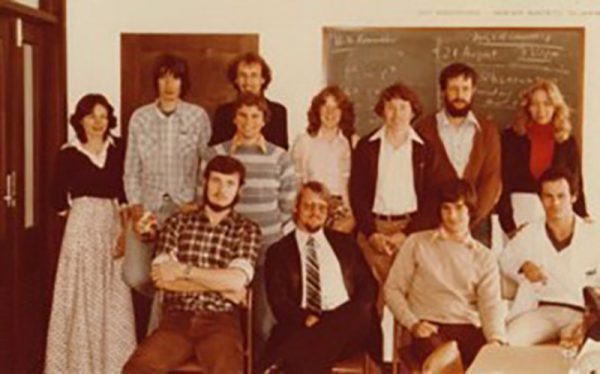
Craig was born in 1958 in Calgary, Alberta, Canada to English parents, has two other sisters, one English and the other Canadian too, however, he spent most of his life growing up in England attending a boys boarding school and then a co-ed school where, in his final year before college, he was the only male with 50 girls in a 6th form house! He was an ‘Officer in Training’ in the British Navy learning to fly helicopters, he started flying at age 12 when his family decided to emigrate to Australia in the late 70s.
Craig is proud to say that he paid to come to Australia in 1976, where he began his studies at Murdoch University in Physics.
He and his wife of over 35 years, Carol, are life members of the Kalamunda Bush Fire Brigade. But most importantly to us, Craig has been a part of the Perth Observatory for over 30 years. Craig credits his wife with helping him find his first job in Australia.
“I had finished my degree but couldn’t get a job. I’d applied for 134 jobs with no luck. So I was filling out an application for the ‘dole’ when Carol saw a job advertised for a night assistant position at Perth Observatory. I didn’t feel very positive about my chances but I got an interview on Friday and was told how overqualified and under-experienced I was. I was really tired of hearing this so said if they couldn’t find a use for me, it was their problem and left! I got the job on Monday.”
The Working Years
Craig arrived at the Observatory on 2 February 1982 and started working in the Meridian Section as an Observer. He soon became Senior Observer and was taken under the wings of Peter Birch who was in charge of the prestigious Lowell-Perth telescope. Craig worked with him in his spare time as an Observer and also helped with computing and data reduction; today they are still best of mates.
Craig’s main interest was in IT and one instance he took Peter’s data, which was previously plotted on graph paper, and interfaced it to a flatbed plotter that was faster and more adaptable. “Everything was changing, we were using IT more.”
“We all worked on every telescope – which one depended on who the boss was and what needed to be done”. He became a night owl. In the Meridian, they rotated 2 x 15 hour night shifts (4:30 pm to 8:30 am) and 1 day a week office hours. This alternated fortnightly for the 37.5 hours they were paid for but they all did much more. Craig worked on the 24″ Lowell, was Senior in the Meridian doing a lot of the organisation and administration, and worked on the Astrographic. Because of this, he got the opportunity to do a few of his own programs outside of his normal duties, including starting the West Australian Lunar Occultation Group, a worldwide group managed by Carter Observatory in Wellington, New Zealand for the Southern Hemisphere. He and Graham Blow worked on this program using the 24” and a lot of volunteer help.
Craig also worked on the Perth Observatory’s Astronomical Data Handbook as well as responding to queries from members of the Public, attending court cases as an expert witness for sunrise/set times. Both he and Steve Ewing were also presenters on Radio 6PR ‘Nightline” as resident astronomers.
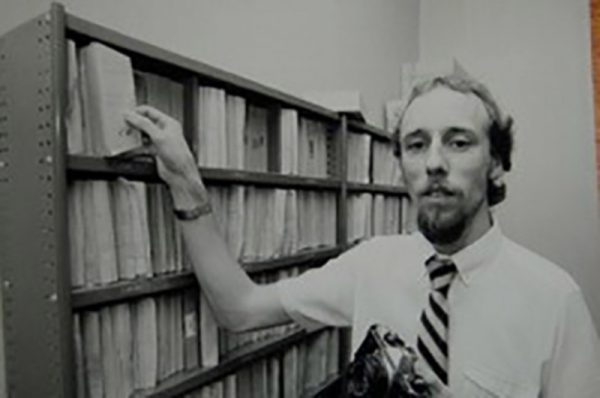
“In the old days, to be an Astronomer in the Public Service you had to have a tertiary qualification and be doing extra work and projects outside the norm that gets you recognised by other professional Astronomers.”
Craig had a degree in Physics and with the additional work he was doing, quickly progressed through the ranks to a scientific officer Level 2/4. Having acted in several of the professional Astronomers positions during their holidays, and attended courses on management development
“One day I was called into the office with I think Peter Birch, Dr Ivan Nikoloff and Mike Candy and was told that I was now an Astronomer!”
“I was obviously filling a previously vacant position, the letter from the Public Service arrived shortly later”.
Based on that, Craig was “given” his own telescope to use, The University of WA telescope, that had sat idle for many years, and started his own program in the field of double stars using a Filar Micrometer; “Believe it or not, this was originally an asset of Mt Stromlo on permanent loan”.
In 1987 as part of the WA Inc Burke-Dowding cutbacks, 50% of the staff were re-deployed, most from the Meridian Section. Craig, Steve Ewing, Mark Kempin and Lloyd Walsh from the Meridian team ended up in the Department of Land and Surveys, Craig programming in Fortran on the GESMAR (Geodetic Mapping Register System) a system still running today.
Craig then moved to Conservation and Land Management (CALM) as PC Support and PC Training Officer “…in the day when we were using DOS 3.0 and Windows for Workgroups, as well as Wordstar 2000 and Word Perfect 5”. He then moved into Systems Programming on Digital Equipment Corporation with Craig looking after the mainframes and Graphical Information Mapping Systems as well as CALMs network.
In 1994 Mike Candy passed away and Craig was asked back to Perth Observatory on secondment from CALM to look after the Astrographic Department. After some time, CALM outsourced its IT to private industry, so Craig went to the outsourcing company, Digital Equipment Corporation (DEC), working as Co-Manager and Consultant for the Outsourcing Mining Centre for WA and looking after over 40 companies; DEC became Compaq and eventually evolved into HP.
Craig then moved to Wesfarmers Rural as Technical Services Manager to look after over 300 sites across Australia. Constantly looking for new challenges, Craig then went to AOT Consulting, then the Department of Culture and Arts as 2IC in Information Management and looking after 7 government departments, before returning to AOT Consulting (the first person to be asked back to this company). His last full time paid job was 2IC in IT at Legal Aid Australia. In the last two years, he has worked part-time in Local Government, Kalamunda and Rockingham, in bushfire risk management and mitigation.
Craig began his Master’s part-time in 2010, which soon turned into a PhD. In 2013 he retired and returned to Perth Observatory for the third time – now as a Volunteer.
His hobbies are Classical music, Opera, Wine, Scottish Single Malt Whisky, vegetable gardening and eating and cooking.
Ditties from the Domes
Craig is keen to share some of his tales from working at Perth Observatory. This is just a taster of more that is to come!
The Uni Dome
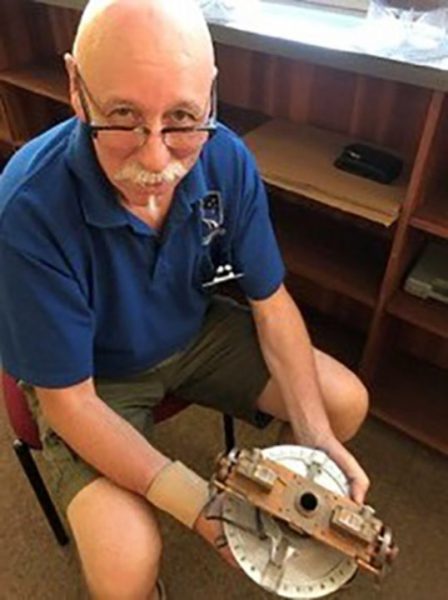
This story is about the Filar Micrometer in the University Dome. “Many don’t know that we had to farm Red Back Spiders so that we could use their web in the Filar Micrometer. Only the silk from their web was fine and strong enough to make the crosshair on the Micrometer. The Technical Manager, Arie Verveer, used to get his assistant to hold the web taut on either side of the eyepiece whilst he used nail polish to glue it in place. His favourite trick was to paint his helper’s nails too – in whatever colour was handy – red, pink! If it was a humid night the web would snap and no more viewing could be done until the crosshair was replaced, and so it would all begin again.”
Lowell Dome and the 24″ Telescope
“It was 1986 and the Americans had brought over a CCD camera to observe Comet Halley. Professor Mike A’Hearn also brought a PhD student, Susan Hogan. One night, Susan and I decided we wanted to change the way we had been told to observe. As a result, we thought we’d broken the CCD! Mike wanted observations in a particular wavelength for about 10 seconds. When we saw the image on the screen we thought it was a piddly little dot so we decided to observe it for 5 minutes. When the image appeared, we thought we’d overexposed it; it looked like a Catherine Wheel. We changed it back and the next image was back to the little dot. At 2 am we rang Mike and told him what we’d seen. He dropped the phone and arrived 30 minutes later. We showed him what we’d done and Mike said “Well, it’s out there. We’re famous!”. It was serendipity, but we had found Spiral Arms. It was the first time that spiral arms on a comet had been observed. It made front-page news of the prestigious Journal Nature and we became famous for it, for a second or two!”
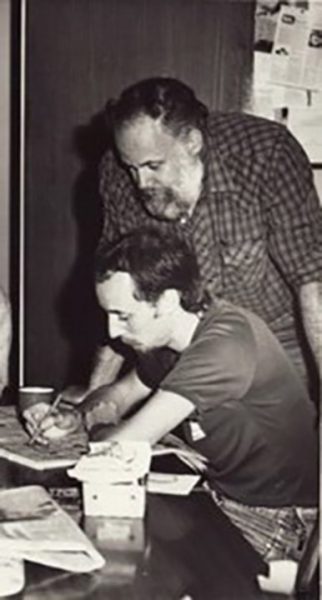
“Steve (Ewing) and I used to sit on top of the 24″ Dome with a coffee to watch the sun come up after night shifts. One night, the weather came in. The power went off but we had to close the Lowell dome! There we were with no tethering or harnesses in those days, climbing over the top of the dome and tying canvas tarps over the opening to protect the telescope. There was no Occupational Health and Safety in those days!” but we were still seriously chastised the following day by Dr Nikoloff.
Astrographic Dome
“I was never a good Astro Observer. One night, I went downstairs to get some new plates from the darkroom. Steve (Ewing) was visiting and left to go back to the Meridian. I was halfway back up the stairs when Steve ran back screaming, “It’s raining!!” We closed up very quickly and told Mike Candy the following day. Luckily there was no damage, but it was embarrassing.
The Meridian Dome
“We were continuing constructing the largest stellar catalogue in the southern hemisphere, this time Perth 83. Dennis Harwood, Steve Ewing, Mark Kempin, Lloyd Walsh and myself were responsible for most of Perth 83. It was the last catalogue before satellites took over. The Germans did the first with Perth 70 and Dr Nikoloff did Perth 75.
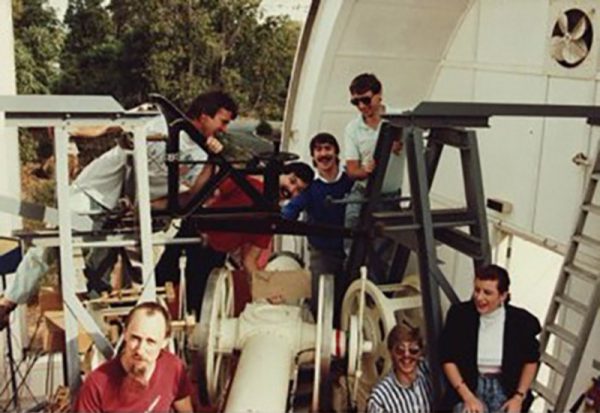
“Imagine spending a 15 hour night shift in the dead of winter. We started wearing sleeping bags with legs cut into them but they had no neck. We couldn’t stand quickly without getting a painful sensation in the nether regions when we had the hood up. Eventually, we ended up with Ski Suits. We would eat all night just to keep warm whilst listening to “Hitchhikers Guide to the Galaxy”. We’d also ring the local radio station and annoy them by asking them to play “On a Hot Summer’s Night”.
We are so grateful that Craig has returned to the Observatory as a volunteer. His continuing work with cataloguing and sorting the many years of stored papers and items has been invaluable. We all know when Craig is in as we can hear the classical music wafting through the building. Another bonus is that whenever we find something unusual he instantly knows what it is, its use and a good story about it!





